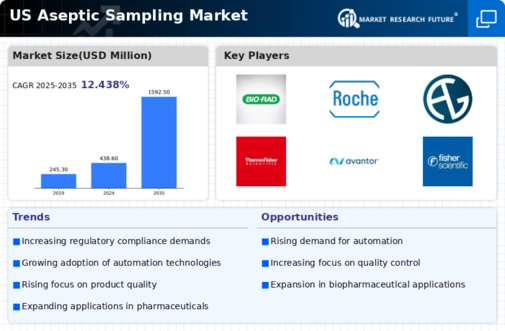Rising Demand for Biopharmaceuticals
The aseptic sampling market is experiencing a notable surge in demand driven by the increasing production of biopharmaceuticals. As the biopharmaceutical sector expands, the need for reliable and sterile sampling methods becomes paramount. In 2025, the biopharmaceutical market in the US is projected to reach approximately $300 billion, indicating a robust growth trajectory. This growth necessitates the implementation of aseptic sampling techniques to ensure product integrity and compliance with stringent regulatory standards. The aseptic sampling market is thus positioned to benefit significantly from this trend, as manufacturers seek to adopt advanced sampling solutions that mitigate contamination risks and enhance product safety.
Growing Awareness of Contamination Risks
There is a heightened awareness regarding contamination risks in the aseptic sampling market, particularly within the pharmaceutical and biotechnology sectors. As companies strive to maintain high-quality standards, the adoption of aseptic sampling methods is becoming increasingly critical. Contamination can lead to costly product recalls and regulatory penalties, which can severely impact a company's reputation and financial standing. The aseptic sampling market is responding to this challenge by offering innovative solutions that minimize contamination risks. This trend is likely to drive market growth as organizations prioritize the implementation of effective sampling protocols to safeguard their products and ensure compliance with industry regulations.
Expansion of Research and Development Activities
The expansion of research and development (R&D) activities in the pharmaceutical and biotechnology sectors is a key driver for the aseptic sampling market. As companies invest in R&D to develop new therapies and products, the need for reliable sampling methods becomes increasingly critical. In 2025, R&D spending in the US pharmaceutical industry is projected to exceed $100 billion, highlighting the importance of effective sampling techniques in the development process. The aseptic sampling market is likely to benefit from this trend, as researchers require advanced sampling solutions to ensure the integrity of their studies and the quality of their products. This growing emphasis on R&D is expected to propel market growth in the coming years.
Regulatory Pressures and Compliance Requirements
The aseptic sampling market is significantly influenced by regulatory pressures and compliance requirements imposed by health authorities. In the US, organizations must adhere to stringent guidelines set forth by the FDA and other regulatory bodies, which mandate the use of aseptic techniques in the production of sterile products. This regulatory landscape compels companies to invest in aseptic sampling solutions that meet these requirements. The aseptic sampling market is thus positioned to grow as businesses seek to align their practices with regulatory standards, ensuring product safety and efficacy. The ongoing evolution of these regulations may further drive the demand for advanced sampling technologies.
Technological Innovations in Sampling Techniques
Technological advancements are playing a pivotal role in shaping the aseptic sampling market. Innovations such as automated sampling systems and advanced filtration technologies are enhancing the efficiency and reliability of sampling processes. In 2025, the market for automated aseptic sampling solutions is expected to grow at a CAGR of 10%, reflecting the increasing adoption of these technologies. The aseptic sampling market is witnessing a shift towards more sophisticated sampling methods that not only improve accuracy but also reduce the risk of human error. As companies invest in these technologies, the market is likely to see a significant transformation, leading to improved product quality and compliance.




















Leave a Comment